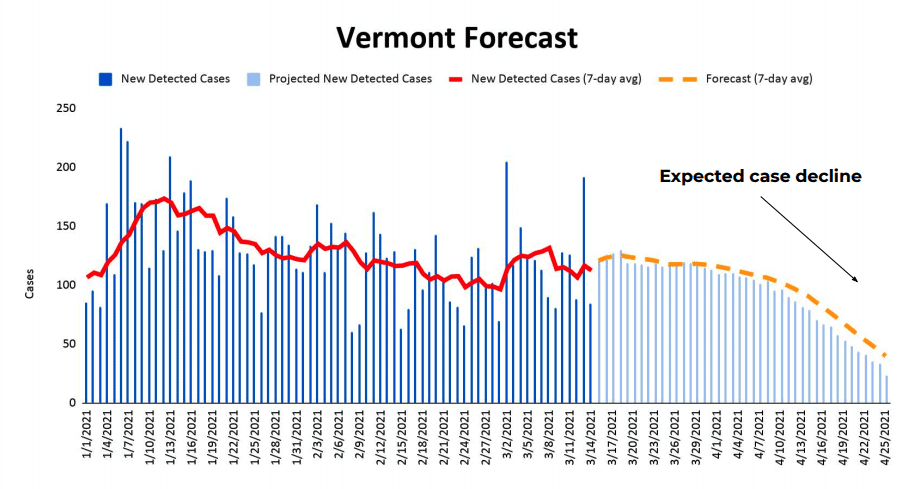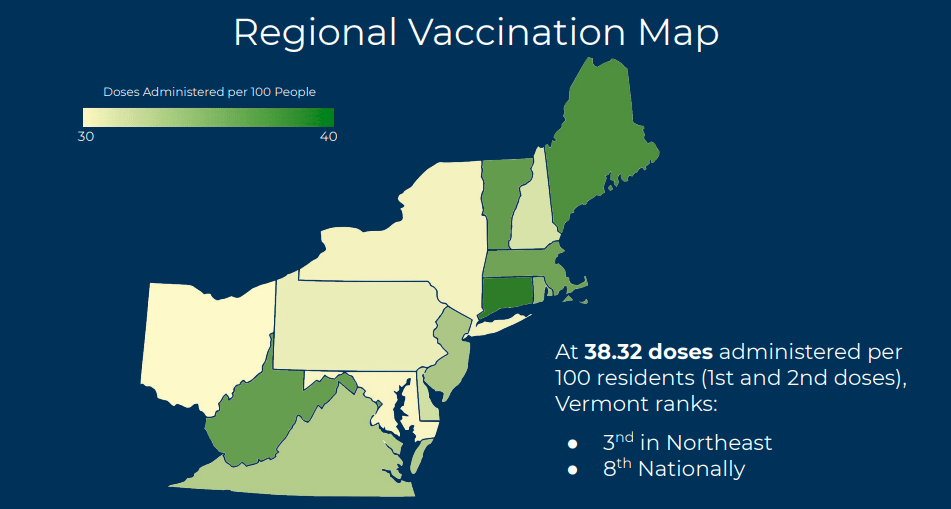
By Erin Petenko/VTdigger
Based on increasing Covid-19 vaccine supply, Gov. Phil Scott estimates that life in Vermont could return to normal by the Fourth of July, he said Tuesday, March 16 at his twice-weekly press conference.
Scott learned in a national call with the White House on Tuesday that vaccine makers are ramping up their production, and Vermont should get a major boost in its federal allocation by the end of the month.
Scott said he believes the additional vaccine will allow Vermont to speed up its goals for vaccinating people in particular age bands. To help Vermonters estimate when they’ll become eligible for vaccination, the state plans to lay out its schedule on Friday, March 19.
President Joe Biden announced last week that he will require all states to expand eligibility to the general adult population by May 1, with a return to some level of normalcy by the Fourth of July. Scott said Vermont could meet or even surpass that timeline.
“And that’s what we believe we can deliver on, and possibly exceed,” Scott said. “As you’ll see, if supply comes in as promised, we hope anyone who wants a vaccine will have the opportunity to be fully vaccinated by the summer, which will allow us to get back to normal.”
Vermont’s vaccine supply won’t increase much in the immediate future. The state expects to receive a total of about 800 more doses next week than this week from all three manufacturers, Scott said. That includes 250 that go directly to the federal pharmacy program to use at local pharmacy retailers.
But Pfizer, Moderna and Johnson & Johnson plan to increase their manufacturing speed in the coming weeks. Pfizer and Moderna expect to have a combined national allocation of 15 million to 17 million per week, and Johnson & Johnson plans to distribute about 4 million to 6 million per week.
That would lead to an increase of 4,000 to 5,000 doses for Vermont’s vaccine program, Scott said.
At the moment, Vermont’s eligibility includes those 65 and over, high-risk Vermonters of any age, school and child care staff, and correctional staff. People who were eligible in previous categories, such as those 75 and older or health care workers, continue to be eligible for the vaccine.
Vermont’s next eligibility category will include Vermonters 60 and older, Scott said. The state plans to announce the timeline for eligibility for everyone 16 and older on Friday. Adults can register on the state’s website now to be ready to sign up.
The state has also added some details to the Department of Health website about clinics targeted at Vermonters of color.
Scott said the state could still have some precautions in place through the summer, depending on the pace of vaccinations and the virus, such as mask-wearing and a closed border with Canada. “Again, a lot of what-ifs,” he said.
“But it’s almost like we’re back to where we were pre-pandemic, in terms of having businesses open, and being able to freely travel throughout the United States,” he said, referring to his expectations for summer.

The pace of vaccination
About 28% of Vermonters 16 and older have received at least one dose of the vaccine, including 70,100 who have begun their vaccination and 82,700 who have completed it.
More than three-quarters of Vermonters 70 and older have gotten at least one dose of the vaccine, and about half of those 65 to 69 years old have had at least one dose. About 7,000 school and child care staff members have been vaccinated so far, said Mike Smith, secretary of the Agency of Human Services.
Not everyone who is eligible has elected to receive the vaccine so far. Dr. Mark Levine, commissioner of the Department of Health, said he hopes that more information and more confidence in Vermont’s progress will change that.
“If many people were hesitant because they had safety concerns or had concerns about it being so new, they’ve all begun to continue to see that (the vaccines are) used successfully and safely and effectively,” he said.
Scott said people should also see the benefits of getting the vaccine as time goes on. “It’s a pathway to more freedom and more mobility,” he said.
Four new cases of the variant found
The state has identified four new cases of the B117 United Kingdom variant, bringing the total to five, Levine said.
Levine said he couldn’t estimate how many total cases there could be in the state so far, because Vermont checks only a small percentage of Covid cases for the variant.
“It’s not a random screening of samples, and it’s not a really robust distribution of samples anywhere in the country at this point,” he said.
He said the Centers for Disease Control and Prevention plans to ramp up genomic sequencing that tests Covid samples for the variant. Vermont is also working on adding the capacity to perform that sequencing at its own public health labs.
Levine said the number of variant cases is expected to increase as it spreads nationally.
“We should assume because we found five here in Vermont that it’s probably more prevalent than we would have imagined,” Levine said. “And, as I’ve said in the past, everyone has been saying that by the end of March, it may be the dominant strain in our country. So, this was just the tip of the iceberg.”
Covid cases mostly steady
The latest presentation from Mike Pieciak, Department of Financial Regulation commissioner, suggests that Vermont’s numbers are neither spiraling out of control, nor dropping dramatically.
The state reported 790 cases in the past week, a decline from 903 the week before but higher than the weeks before that, the presentation shows. State case numbers had been dropping for several weeks but increased again, partly due to the Northern State Correctional Facility outbreak in Newport.
Statewide numbers are predicted to remain about the same level — roughly 100 to 150 cases per day — for the next few weeks, then decline as more Vermonters are vaccinated, Pieciak said.
He highlighted data that suggest continued progress in preventing severe cases of the disease. The median age of Covid cases has declined from a peak of about 43 years old in December to about 33 years old in the past week.
The state has also made progress in the number of long-term care facility cases, a demographic that has had a high fatality rate. Pieciak said the vaccinations are the “single greatest item” affecting Vermont’s cases right now.
“This chart [of vaccines] here holds the key: The higher these percentages go, the faster and more normal our recovery will be,” he said.
On Tuesday, the health department reported 53 new cases and no new deaths, bringing the total deaths to 215. Twenty-four people are hospitalized for the virus, including three in the ICU.



